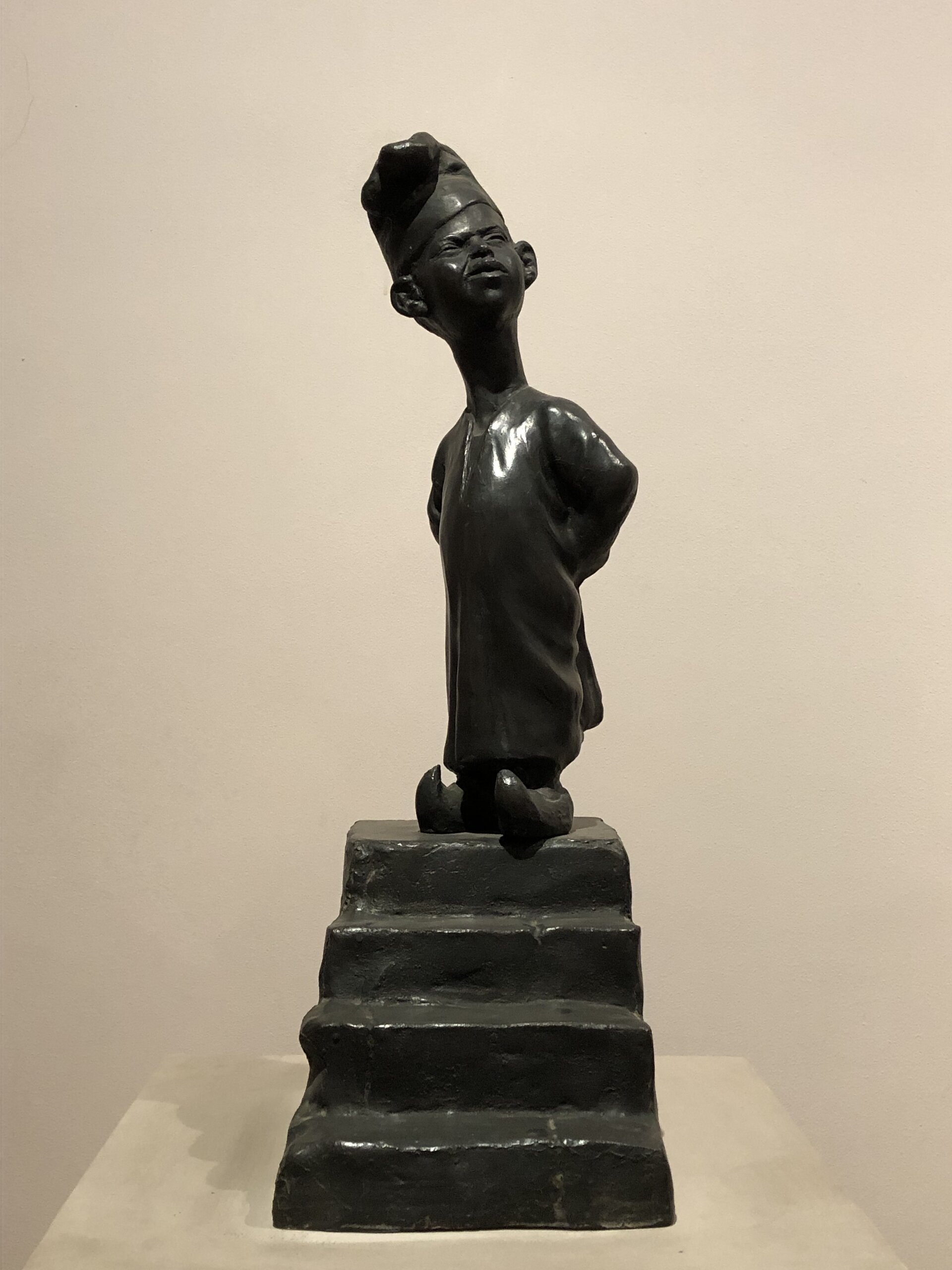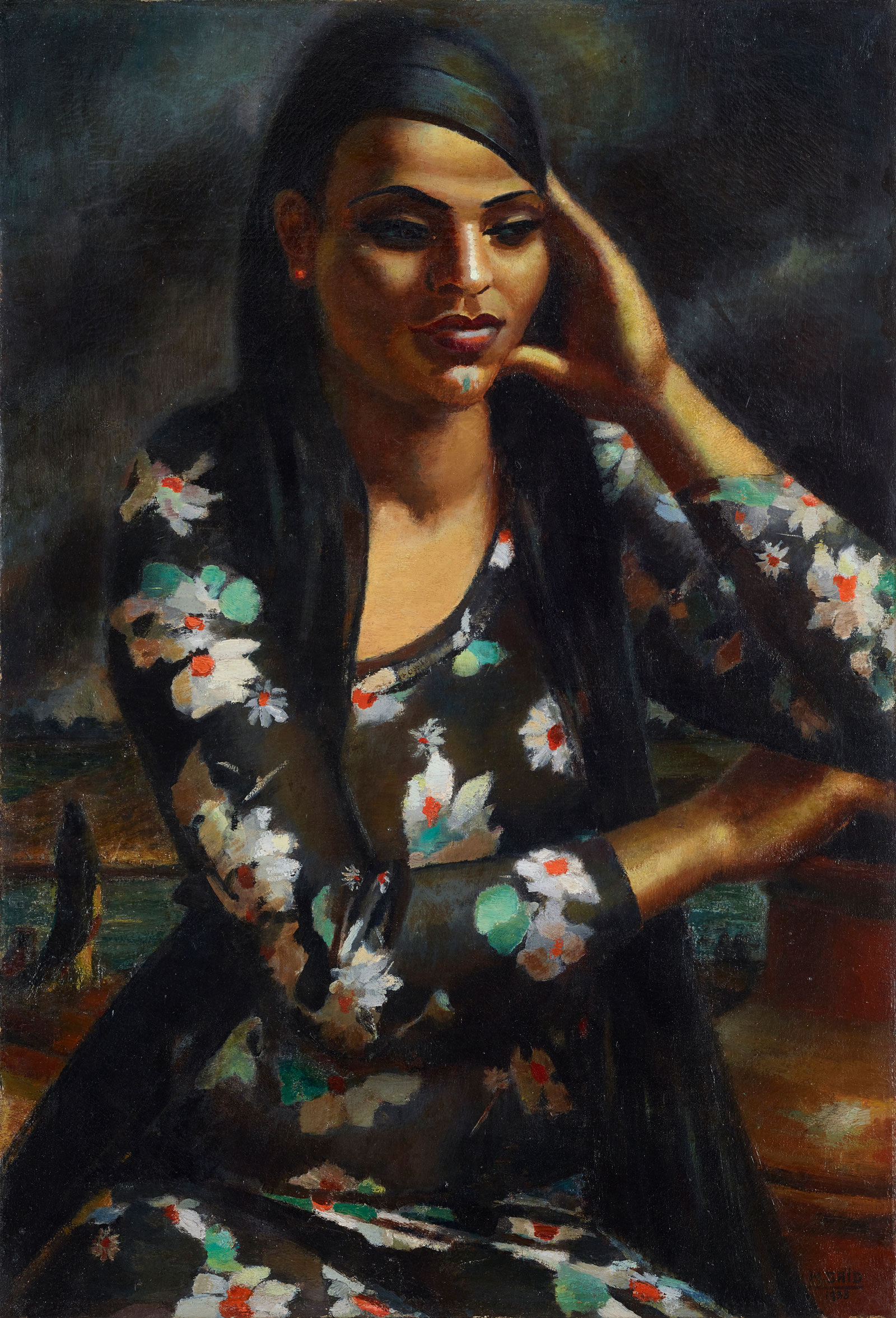In 1911, the exhibition of the first class of students at the École Égyptienne des Beaux-Arts (Madrasat al-Funun al-Jamila al-Misriyya) was held at the Automobile Club in Cairo. Among these graduate students was the Egyptian sculptor Mahmoud Mokhtar (1891-1931), who presented a small bronze statue entitled Ibn al-Balad (The Son of the Country) (fig.1). It received great success with the public. This amusing artwork represents a little boy with a mischievous face and wearing the typical garment of the Egyptian plebian man: a tarboosh on his head, a galabiyye (traditional dress), and babouches. A year after this debut, Mokhtar left Egypt for France, where he enrolled at the École des Beaux-Arts in Paris.
Simultaneously, Egyptian writer and journalist Mohammed Hussein Haykal (1888-1956) was studying law in the French capital city. He was concurrently writing Zaynab, published in 1913. Celebrated as the first genuine Egyptian novel, it presents a detailed description of the life in the countryside where Zaynab falls in love with Ibrahim, a farm supervisor. Although these two oeuvres might appear to be anecdotic, it is interesting to notice that Mahmoud Mokhtar (1891-1931) and Mohammed Hussein Haykal (1888-1956) chose to focus their respective primary works on the Egyptian peasant: al fallah [1].
Under the reign of King Fuad I (1922-1936), Egypt was on the best of terms with Europe, especially France. In the 1920s and 1930s, the urban landscapes of Cairo and Alexandria looked like capital cities from the Old Continent. Rich expats and members from the Egyptian high society mixed together in selective places such as the Guezira Sporting Club, the Mohamed-Ali Club, and the Automobile Club. However, behind this glorious front, 90% of the population in Egypt made a living from agriculture – according to statistics from 1924[2]. The peasants were subjected to the rules of agrarian capitalism, established by large landowners, and lived in miserable conditions. Therefore, it is not surprising to see that they significantly participated in the Revolution of 1919 against the British control, as Saad Zaghloul (1859-1927) said: “(…) ceux qui portent des dejllabas bleues [caractéristique des paysans] sont des figures de la revolution” [3].

Figure 1 Mahmoud Mokhtar, Ibn al-Balad, bronze,
20 x 27 x 57.5 cm.Mahmoud Mokhtar Museum,
Cairo, Egypt. Photograph by the writer.
Hence, at a time when Western culture was highly promoted in artistic circles and institutions, why did the image of the peasant attract the first generation of Egyptian artists? How did they interpret this image in their artistic programs? Nowadays, peasant imagery is held up to ridicule by popular culture, portraying them as “uneducated bumpkins, gullible, dirt farmers or hillbillies (…)”[4]. Nonetheless, this imagery played a key role in the construction of the modern Egyptian nation.
The Egyptian Countryside: A Source of Freedom
In a session held at the Institut Égyptien in March 1911, Guillaume Laplagne (1874-1927) stated: “It is the landscape and the study of the nude that will lead the painter and sculptor to pure Egyptian inspiration: the countryside has hardly changed and neither did the people. He will see the fellah busy with the same work as the peasant in ancient bas-reliefs (…)”[5].
Although this vision, endorsed by the first director of the École Égyptienne des Beaux-Arts (Madrasat al-Funun al-Gamila al- Misriyya), appeared to be encouraging the elaboration of a national Egyptian art, the educational system provided by the institution was quite different. In fact, it corresponded to the model of the École Nationale Supérieure des Beaux-Arts in Paris[6]. Young Egyptian students trained under the supervision of European teachers, in nude painting from live models, as well as copying artworks by classical and 19th
century European masters.
Free of charge, and with non-restrictive conditions of admission, the establishment received 220 Egyptian students. Some were from the Egyptian countryside, like Mahmoud Mokhtar (1891-1931), and Raghed Ayad ((1892-1982). It is then possible to deduce that the academic environment, in which they were evolving at the École Égyptienne des Beaux-Arts (Madrasat al-Funun al-Gamila al- Misriyya), and living in Westernized Cairo, somehow distanced them from their original backgrounds. They also both completed their training in Paris or Rome, immersing themselves in European culture. Yet, the seminal example of artworks by these students clearly show a detachment from this educational system, to which Ragheb Ayad (1892-1982) did not adhere, as he confessed: “I have to be honest with you. (…) I have always hated – and still do – pure academic studies, such as drawing from statues, because in my opinion they are lifeless (…)”[7].
These professional Egyptian artists of that generation were named ‘al-Ruwwad’ (The Pioneers), and produced innovative artworks. Adopting modern styles, they appropriated the theme of rural life. They did so as a source of freedom and experimentation in order to challenge the strict rules of European classical painting, to which they had been conditioned. They wanted to show what corresponded to scenes from reality, as in the painting titled The Peasant and his cows (1961) (fig.2) by Ayad. Moreover, they intended to portray an authentic image of the Egyptian peasant, and not an exoticized one.
JPG.jpg)
Figure 2 Ragheb Ayad, The Village Market, 1938, oil on burlap on wood,103 x 157 cm.
The Museum of Modern Egyptian Art, Cairo, Egypt. Courtesy of the Museum of Modern Egyptian Art.
In Search of Egyptianess
In the collective imagination, the fallah is seen as a person who would perpetuate a traditional lifestyle. Whereas, the bourgeoisie was ‘corrupted’ by the West, adopting European habits and leisure. Egyptian scholar Samah Selim connects the figure of the fallah to the two following notions: al-khussusiya (the specificity) and al istimrariya (the continuity)[8]. First, the life of the Egyptian peasant is specific to the Egyptian culture. That is precisely what characterizes Egyptianess. The fallah ensures the values as well as the traditions of Egyptian culture. This lifestyle has stayed untouched for millennia, as he repeats the same traditions, especially working in the fields.
In the beginnings of the modern art movement in Egypt, it is worth noting that rural Egyptian life did not only catch the attention of artists from peasantry backgrounds. Unlike some of their contemporaries, Mahmoud Saïd (1897-1964) came from a prominent family in Alexandria, and Mohamed Naghi (1888-1956) was actually the son of a landlord. Though having grown up in the tight circle of the Alexandrian elite, they did not live strictly separated from the working-class people and the fallahin. For example, Mahmoud Saïd (1897-1964) worked as a Judge at the Mixed Court of Mansoura and Alexandria between 1927 and 1947, before dedicating his entire life to painting. This early professional experience enabled him to frequent people from the popular classes.
Accordingly, it is interesting to take a closer look at the artistic process of these above-mentioned artists. Travel was a constant practice. These artists would leave their ateliers to go on trips all over the country. Naghi used to extensively travel to Upper Egypt, and sometimes to remote villages, where he showed a particular fascination for the local craftmanship (jewelry, kilim rugs, and embroidered garments). It has been reported that he even liked to collect them[9]. As for Saïd, he would get closer to the water, riding along the Mediterranean coast (Abu Qir, Rosetta), or standing by the banks of the Nile in the city of Talkha. Everywhere he went, he contemplated the peasants who were working the fertile land of Egypt. These experiences demonstrate that Naghi and Saïd were willing to approach the fellahin as much as they could. Strikingly, choosing this subject of illustration could be identified as ‘social treason’, involving the breaking of the conventions of the social circle to which the person belonged. Depicting the daily work scenes, as seen in the painting Ila al-Souq, Bai’i al-Firakh (1931) (fig.3), was a way to better understand the customs and the traditions of their compatriots – which should have also been their own tasks.

Figure 3 Mohamed Naghi, إلى السوق- بائعي الفراخ , 1931, oil on canvas, 56 x 80 cm.
The Ramzi and Saeda Dalloul Art Foundation, Beirut, Lebanon.
The Alexandrian masters were keen observers of the peasantry, as they aimed to emanate from them the true Egyptian identity. Detached from an Orientalist vision and an urban conception of the fallah, they both developed an artistic practice, which is somehow similar to an anthropologic process. Paying attention to details, especially the physical features, Naghi and Saïd executed an impressive series of portraits, like the painting Fille à l’imprimé (1938) (fig.4). This series reveals their intention to elevate the figure of the peasant in the visual culture in Egypt[10]. In early 20th century Egypt, when the Western cultural hegemony prevailed, the Egyptian folk culture turned into the answer to the question of national identity.

Figure 4 Mahmoud Saïd, Fille à l'imprimé, 1938, oil on canvas,
81 x 55.5 cm.The Ramzi and Saeda Dalloul ArtFoundation,
Beirut, Lebanon.
The Glorification of the Peasant
In the late 19th century, some works by European artists recurrently depicted the Egyptian female peasant wearing a cloak and carrying a water jar. This exact image was constantly seen in real life as in the photographs by Pascal Sébah (1823-1886) (fig 5). It was widely relayed, even as far back as Napoleon’s campaign in Egypt between 1798 and 1801[11]. Later on, the archetypal image of the fallaha served the growing nationalist claims.
.png)
Figure 5 Pascal J. Sébah, Fellahines puissant de l’eau du Nile(Fellahin drawing
water from the Nile), 187-, albumen photographic print, Ken and Jenny
Jacobson Orientalist Photography Collection, Getty Research Institute.
In the first decade of the 20th century, the fallaha became the personification of the Egyptian modern nation. Mahmoud Mokhtar (1891-1934) made her the muse of a rich production of sculptures, especially the monumental one Nahdat Misr (Egypt’s Awakening) sculpted in 1920. Five years later, the Egyptian feminist Huda Sha’arawi (1879-1947) founded the French language magazine L’Égyptienne, whose logo was also a fallaha. This is seen as a symbol of strength and stability, integrated in nationalist visual references.
On April 20th, 1954, the New York Times newspaper released the article by Robert Clark Doty (1975-1974) entitled “Nasser puts Land in Peasant Hands”[12]. Egyptian Prime Minister Gamal Abdel Nasser (1918-1970) distributed to peasants some plots of lands in the Beheira Governate, which was formerly the property of the royal family members overthrown in 1952. This act sent out a strong message, which indicated that the fallahin, long oppressed, had become one of the main concerns, as well as a pillar of the Nasserist revolution. Additionally, it was possible for them to be a stepping stone for the national project. As a matter of fact, the paths of public figures such as singers Oum Kalthoum (1898-1975), Abdel Halim Hafez (1929-1977), writer Taha Hussein (1889-1973), and Gamal Abdel Nasser himself (1918-1970), exemplified the ability of the peasant to climb up higher positions, or to gain international fame.
More than just a folkloric representation, the image of the fallah evolved in the visual culture, as well as in the collective consciousness, in Egypt. It effectively accompanied the birth of the modern nation of Egypt. The Egyptian peasant became part of a plastic language, in which they embodied the strength of the Egyptian identity, and appeared as a perfect symbol of emancipation and power in the fight for independence.
Edited by Elsie Labban



Comments on Imagery of the Egyptian Peasant